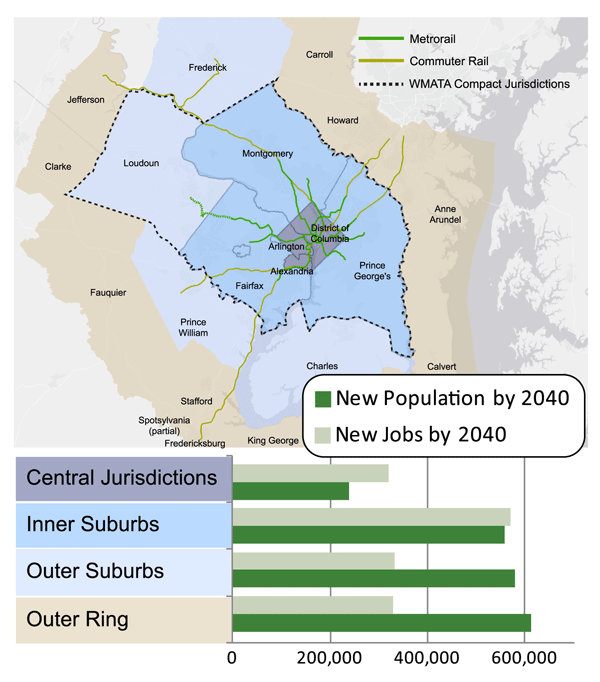Metro – A Place for Business
Metro is critical to the  prosperity of the region and has a positive effect on business activity. Within one half-mile of rail stations and bus stops there are two million jobs, which account for 54 percent of all jobs in the region. The figure to the right shows how future employment will be focused in the Metrorail service areas of the central jurisdictions and the inner suburbs.
prosperity of the region and has a positive effect on business activity. Within one half-mile of rail stations and bus stops there are two million jobs, which account for 54 percent of all jobs in the region. The figure to the right shows how future employment will be focused in the Metrorail service areas of the central jurisdictions and the inner suburbs.
The Washington, D.C. Metropolitan Statistical Area (MSA) added 275,000 households and 295,000 jobs between 2004 and 2010. Of that growth, 6.4 percent of new households and 13.8 percent of new jobs located within one-quarter mile of urban Metro stations and one-half mile of suburban ones. The land area around these Metro stations comprises only 1.2 percent of the MSA land area, so Metro-adjacent locations are capturing far more than an average share of growth. When asked, 83 percent of business leaders surveyed by Metro in March, 2013 noted the importance of Metro to their future success. Employers have chosen Metro station areas as highly desirable places to locate jobs and attract employees. Seventy-seven percent of them said the proximity of a Metrorail station was important to where they decided to locate their businesses.
For more information:
Download both the full Momentum plan and the Executive Summary.
Regional support is important to making Momentum a reality! A number of regional stakeholders have already endorsed Momentum. Please sign on and add your name to endorse Momentum and send the message that public transit is vital to the National Capital Region.


This study only takes in to account current metro rail lines as it stands.
Theres no information on the growth rate if metro was extended into the area of Potomac mills.
This would attract more jobs, and people to the area then this study sheet states.
If these projections are taken from COG, as WMATA’s demographic projections usually are, they actually understate the percentage of jobs and housing that will be near Metro.
As I understand it, COG does not do an independent forecast of future development location on its own. It compiles forecasts from each jurisdiction and reconciles them to its forecast of total regional growth (which it does do on its own). Forecasts for the outer suburbs are typically more optimistic than those for inner areas.
One reason for this is that local planning agencies are hesitant, for political and legal reasons, to forecast growth in excess of current zoning. The outer suburbs are zoned for more sprawl growth, while growth in inner areas generally requires rezonings which must overcome bureaucratic inertia and political opposition. As a result, the rezonings don’t happen until an area is “ripe” for development, and development that will happen in the 2030s is not at all ripe.
Another reason is that forecasts generally extrapolate past trends. Current, and likely future, trends are for more central-area development and less sprawl development than in the past. The shift in trends is only partially reflected in the forecasts.
Metro is good for business. If you are in the taxi cab business.